For students of the dharma with physical disabilities, one of the recent positive developments of living under quarantine has been the ability to join a digital sangha anywhere in the world, at any hour of the day, from the comfort of home. But the online shift has also revealed where the Buddhist community sometimes falls short when it comes to accommodating people who face physical challenges.
Before COVID-19, people with disabilities who wanted to attend a meditation class or dharma talk would often have to navigate older buildings with limited wheelchair access. There was also the added physical and mental stress of getting there. Tricycle spoke to several people in the disabled Buddhist community to get a sense of how things have shifted for them since Buddhist centers began moving their programming online.
***
“It’s just horrible if you travel somewhere and you’re absolutely shattered by the journey. Then you have to sit through something while your pain is all flared up and you’ve still got to get home at the end.”
In her twenties, Buddhist teacher Vidyamala Burch suffered two injuries to her spinal cord and today she relies on the assistance of a wheelchair. With pain as her constant companion, she uses mindfulness meditation to ease the emotional suffering that accompanies her injury. Ordained in the Triratna Buddhist Order in 1995, Burch’s personal struggles translate readily to her work as a meditation teacher. “I want to help people out of their suffering—and what we call secondary suffering—which is all the stuff we add to our basic unpleasant experience,” she said, speaking to her desire to be of service to both disabled and non-disabled people.
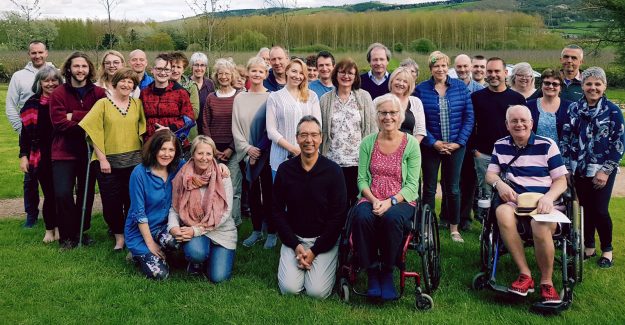
In 2004, Burch co-founded the UK-based mindfulness organization Breathworks, which now has accredited teachers in over 35 countries. The organization made the prescient decision to move their introductory teacher training courses online in January, a few months before the UK government mandated a quarantine. Offering the courses on the internet was something Burch has wanted to do for some time.
“There has been a popular view that face-to-face is better. Maybe it is,” she remarked. But in the wake of the coronavirus pandemic, the debate over whether online meditation is as effective as in-person is no longer an abstract discussion, but a reality practitioners must live with. “Now we can’t have face-to-face and it’s like, oh wow—online can be very, very good.”
Although Burch has found a freedom in facilitating the course offerings online, she does miss the in-person encounters that come with being able to visit the outside world. Burch is also cut off from the physical therapy she relies on in order to function at her best. “I can’t go to the osteopath, I can’t go to a massage therapist,” she shared. “I have these certain things alongside my mindfulness and Buddhist practice that keep this jalopy on the road, and now the jalopy is in the garage.
“I’m having to work with my mind really, really hard, because that’s all I’ve got now.”
Even before COVID, some Buddhist centers, like the Black Lotus Collective, strived to accommodate the needs of their members with varying physical capabilities. Since its inception in 2015, the Boston-based contemplative group has aimed to center the voices of those with marginalized identities, including people with different access needs. “The heart of our work is undoing the ableism within ourselves so that when people with different abilities come to our space, we can hold them and see them fully,” Black Lotus Collective co-founder Grant Jones told Tricycle.
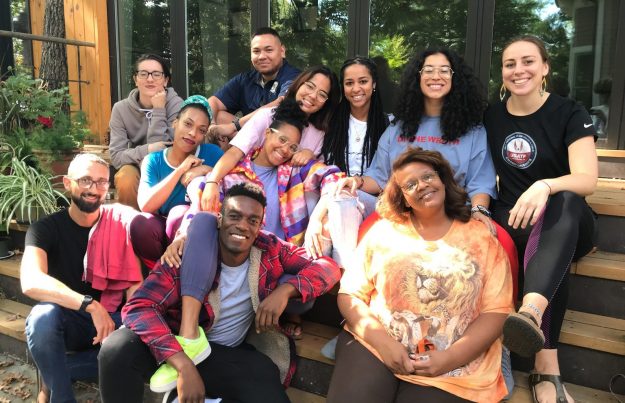
Before the lockdown, the Black Lotus Collective began their monthly meditation meet-ups by asking their members what they needed. “We had members who asked us to speak louder because they are hard of hearing,” said fellow co-founder Juliana Santoyo. “Or folks who might be holding a lot of physical pain—so we made sure that they were seated in a place that felt comfortable for them.”
As the quarantine continues, they’ve been working to foster community over Zoom and on social media, where they try to bring the same intentionality that they facilitated in their in-person meetings. For instance, posts on Black Lotus Collective’s Instagram include image descriptions so that people with visual impairments can hear a description of the displayed image using a screen reader.
“For us the journey is about what it takes to hold folks who are differently-abled, elderly, and those who have other access needs,” Santoyo said.
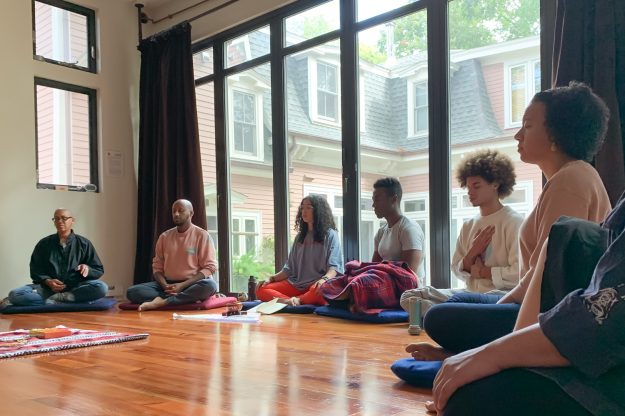
Black Lotus’s efforts draw attention to the fact that, for Buddhists with physical disabilities, these issues are not new. Some have been working for a long time to make Buddhist spaces truly accessible for all.
For meditation practitioners who have hearing loss, finding user-friendly material online or offline is a never ending challenge. Meditation apps are inaccessible without a transcript and online videos often lack closed captioning. Attending an in-person retreat or a dharma talk might mean asking for an additional spot for an American Sign Language (ASL) interpreter who can sit within close proximity to the teacher without being a distraction to the other participants.
None of this is a surprise to Oshin Liam Jennings, a Zen priest who lost his hearing during childhood. In 2015, he founded No Barriers Zen Temple in Washington, D.C., out of the desire to create a place where the needs of the differently abled were centered during the practice. While the sangha is not a Deaf or disabled-only space, services are organized to accommodate members of these communities.
For Rachel Bass, finding a like-minded community that met her physical needs and also deepened her spiritual life was a revelation: “I instantly felt a bond, a connection that I’ve never felt before.”Jennings is one of the only Deaf Zen monks in the world, and thus has been at the forefront of developing ways to share dharma via sign language and other methods. Even before the coronavirus pandemic, he experimented with technology to connect with students in the US and around the world. Using short YouTube videos, in 2017 he created an online ASL dictionary for Buddhist terms.
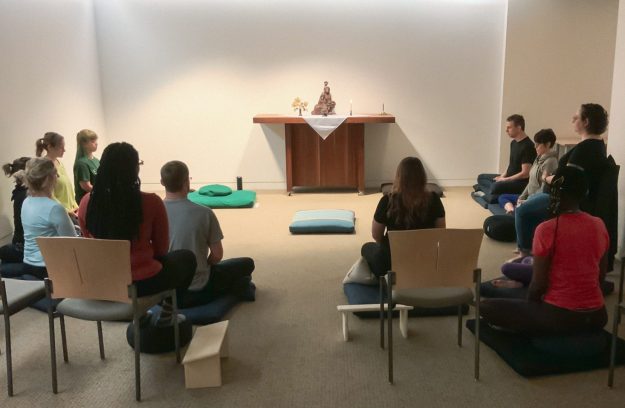
During in-person seated meditations at No Barriers Zen, students do not sit facing a wall, as is tradition, but in a semi-circle facing forward so they can see the strike of the bell through half-opened eyes. “The Zen tradition tends to be very strict, but we are a little more flexible here,” Jennings noted.
No Barriers Zen moved fully online once the coronavirus pandemic hit the US and now the sangha meets bi-weekly over Zoom. Jennings guides the meditation and dharma talks using sign language while an ASL interpreter translates for hearing members. Jennings has found that, for hearing practitioners, watching fellow meditators sign the four bodhisattva vows introduces a way to understand the dharma in a more embodied way. “Sometimes [hearing] students will tell me that they had been chanting twenty, thirty years. But now when they sign and chant verbally, they feel it differently,” Jennings shared.
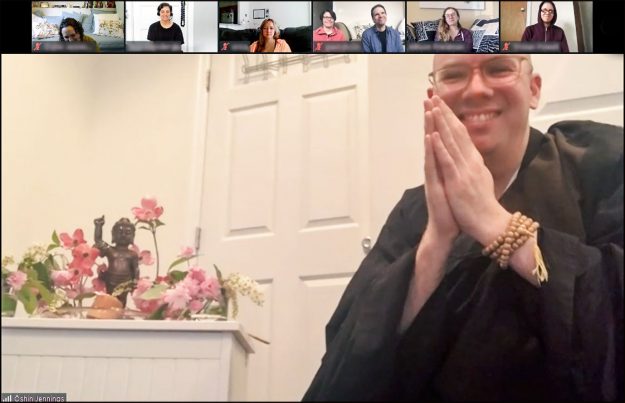
Rachel Bass joined No Barriers as an undergrad at Gallaudet University, where the group met in-person before COVID-19. Raised Jewish, Bass discovered Buddhism in college and developed a regular meditation practice on her own, but felt stymied by the lack of resources available for people living with disabilities like hers. Bass is deaf and uses a wheelchair and a walker to get around. Finding a like-minded community that met her physical needs and also deepened her spiritual life was a revelation. “I instantly felt a bond, a connection that I’ve never felt before,” she said. Bass has since graduated and moved to Florida, but she continues to participate in No Barriers’ offerings online. “I love the fact that I am able to be present with others while meditating regardless of where I am. It is a motivator for my practice as well.”
Audrey Cooper has been part of the No Barriers Zen community since 2018. While she has definitely missed sitting shoulder-to-shoulder with other members of the sangha these last few months, a recent virtual zazen (meditation) session brought with it a gratifying revelation. Sitting on the floor of her home with her husband and two cats, her eyes blinked open before the strike of the bell marked the end of the session. On her computer screen, sitting quietly in meditation, were all the other members of her sangha.
“I just got this hit of the sacredness of the practice and what we are trying to do in this moment,” she said. “Being able to see other people sit in this way was really special.”
♦
Reporting for this article was supported by Public Theologies of Technology and Presence, a journalism and resource initiative based at the Institute of Buddhist Studies and funded by the Henry Luce Foundation.